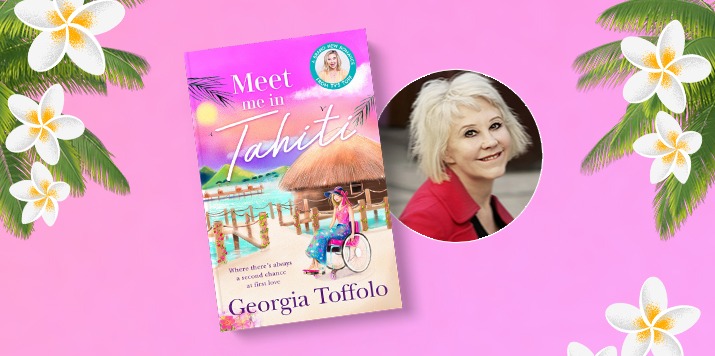We’re joined on our blog by Zoe Taylor, the heroine of Meet Me In Tahiti by Georgia Toffolo and co-written by Avril Tremayne.
Well… we’re sharing the review post Zoe would have written of the beautiful Poerava and Tahiti. This blog is written entirely in Zoe’s point of view by the wonderful Avril Tremayne who has also included a stunning Poisson Cru recipe from the book for you to make at home!
*
I LEFT MY HEART…IN POERAVA
REVIEW BY ZOE TAYLER
Blue.
That’s my overwhelming impression gazing out of the plane window. The endlessness of blue. And not one shade but every shade—ice, crystal, aqua, azure, electric, cobalt, periwinkle, turquoise. It lifts my spirits, even before I realize that emerging from that blue is…a flower.
That flower is Tiare Island, named for its shape, which mirrors that of the Tahitian gardenia (tiare mā’ohi).
In the local language, ti refers to a strength and are means scent, so putting the two words together gives tiare’s literal meaning: strong fragrance. And the tiare mā’ohi has divinely rich and creamy perfume, hinting not only of gardenia but also tuberose, lily-of-the-valley and jasmine, with an added tang of citrus.
But I prefer to associate the name with its ‘regal’ derivation: from the word ‘tiara’. It is, after all, the queen of French Polynesian flowers. Today, more than 100 million flowers are harvested annually and they’re worn daily throughout the islands, but once upon a time only royalty owned the tiare mā’ohi, which was thought of as a gift from the gods—specifically the god Ātea, who engraved his love into the flower’s heart.
As my plane lands, I have no idea that legends like this will become my most cherished memories of this trip. I only know that I can’t wait to explore every part of the glorious Tiare Island—starting with the Poerava resort, situated where Ātea engraved his love: at the centre of the island, where Tiare’s seven petal-shaped peninsulas meet.
As I soon find out, Poerava excels at providing every imaginable opportunity for visitors to explore not only Tiare but the multitude of surrounding islands, so that I feel less like a tourist and more like a local given a secret key to private white- and pink-sand beaches, eateries specialising in local and French delicacies, small-scale traditional businesses farming Tahitian vanilla and black pearls, and uninhabited islets perfect for snorkelling.
Snorkelling. Irresistible in these pure, clear waters, teeming with vibrant, swarming life. There are fish in every imaginable colour, size and shape. Long, thin, silver needlefish. Orange-striped clownfish—hello Nemo! Flat-bodied angelfish with their black, white and yellow stripes. Vivid-blue, yellow-tailed damselfish. A mosaic rainbow of parrotfish in brilliant yellows, pinks, oranges, purples, greens and blues. Starfish in shades of bright blue and brilliant orange. Speckle-skinned grouper (I even get to pat one of those). There are also gracefully gliding manta rays, blacktip and lemon sharks, green turtles, and giant clams in a mind-boggling array of unique blues. There’s even an occasional barracuda to remind me there can be trouble in paradise. (Note to self: steer clear of the barracuda.)
It’s hard to resist the urge to get into the water every single day.
But I want more.
I want, for example, to know about the vanilla that enhances so many dishes at Poerava. And so I visit the Ra’i plantation to learn what makes Tahitian vanilla smell like paradise.
I’m asked to think of the ice cream and cupcakes of my childhood, but I can’t; this vanilla, the rich intoxicating scent seeping through my skin, rich with sweet, spicy, cherry notes, is somehow adult.
Tahitian vanilla bean plants are a type of orchid, with clusters of flowers. Each flower produces only one fruit and that for only a few breathtakingly short hours so that the flower must be pollinated (by hand!) before the flower closes. The fruit—the pod—then goes through a long process of washing and drying before being cured and hand-massaged to distribute its oil and maintain suppleness.
With that level of personal attention, no wonder pure Tahitian vanilla is the world’s second most valuable spice!
Naturally it’s favoured by pastry chefs the world over, but in French Polynesia, Tahitian vanilla is used in many savoury dishes as well—in many fish dishes (give me all the mahi mahi!) for example.
Which brings me to something else I want to know about: Tahiti’s favourite dish!
Luckily poisson cru (which translates as raw fish, or e’ia ote in Tahitian—don’t leave Tahiti without trying it) doesn’t need to be cooked, as such. I’m lucky enough to be instructed in the making thereof by the passionate Gaspard, Head Chef at Poerava. You’ll find the recipe below, so all I’ll say is that poisson cru is more a way of preparing fish than a recipe. The secret is to prepare the dish as quickly as possible. And the ethos? So simple: fresh ingredients—as fresh as the sea itself.
The only thing that can beat poisson cru in my opinion is the lemon soaked crepes served with sugar and friendship at the beachside roulottes on one of Tiare Island’s seven peninsulas, sitting at a table and talking about…well, talking about all those things you’ve longed for, all those things you’re reaching for, all those things you want and need. So easy to think about life under a star-spangled midnight sky—as star-spangled as the Tahitian black pearl, which seems a fitting place to bring my review to a close, given that Poerava is named for the exquisite black pearls of Tahiti.
Black as a midnight sky…and yet not black at all. A kaleidoscopic peacock of dark hues. Grey, charcoal, pewter, silver, the nacre shot through with green and purple and red and gold. Exquisite. Breathtaking. As I gaze in awe at the iridescent dark rainbow shades of them, I can easily believe the myths that swirl around them. That they’re formed in the heads of dragons, or that the moon entices the oysters to the surface of the water to be impregnated by heaven.
These pearls move me in a way I’ve never been moved before—especially when I spot a tiara that reminds me of all that is lush and lovely of this regal island. They talk to me of deep sea mermaids, peeking from beneath the drowning waves at the midnight moonlight, merging land and sea, and call to me of one more legend from my time in Tahiti, of the tiare apetahi, a flower that refuses to grow anywhere else in the world but one special place, and represents the love a woman who once captured the heart of a warrior, only to have him leave her to fight his battles across the sea—lost to her forever…and yet she can’t accept that truth and so she waits, and waits, her heart breaking anew every day she is without him.
As I fear my own heart will break anew every day, waiting to return to the magic where blue merges with blue, and sun meets sea, and midnight is not dark, it’s a rainbow.
RECIPE – POISSON CRU
INGREDIENTS
- 500 grams of sushi-grade tuna, cut into cubes
- Eight limes, juiced
- ½ teaspoon of salt
- 1 tomato
- 1 green sweet pepper, deseeded and cubed
- 1 cucumber, peeled, seeded and thinly sliced
- 1 carrot, peeled and grated
- 1 white or red onion, diced
- 1 glass coconut milk (miti haari – if you want to get serious, grate ripe fresh coconut and squeeze the milk out of the pulp through a cheesecloth—but that’s Gaspard talking, not me!)
- 2 cloves of garlic
- 1 small knob of ginger
METHOD
- Place tuna in a glass bowl and pour over the lime juice
- Mix and massage the lime juice into the tuna, and sprinkle all over with salt
- Set aside for 8-12 minutes (MAXIMUM–the upper case is Gaspard’s)
- Meanwhile combine the tomato, sweet pepper, cucumber, carrot, onion, garlic and ginger
- Remove tuna it from the ‘marinade’ (but don’t throw out the marinade) and add it to the salad
- Drizzle half of the lime juice from the marinade over the tuna/salad and mix well
- Gradually mix in the coconut milk
- Serve and enjoy!
*
Read Zoe’s Tahitian adventure, Meet Me In Tahiti written by Georgia Toffolo and Avril Tremayne now!



